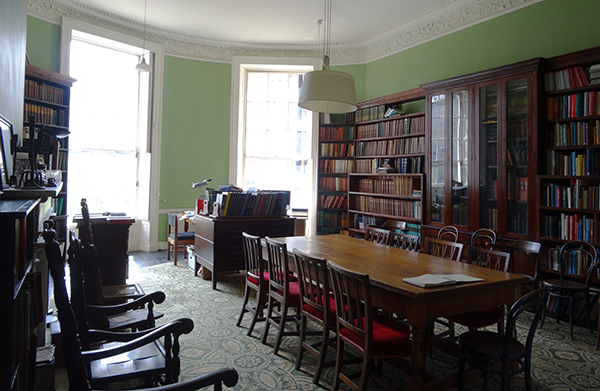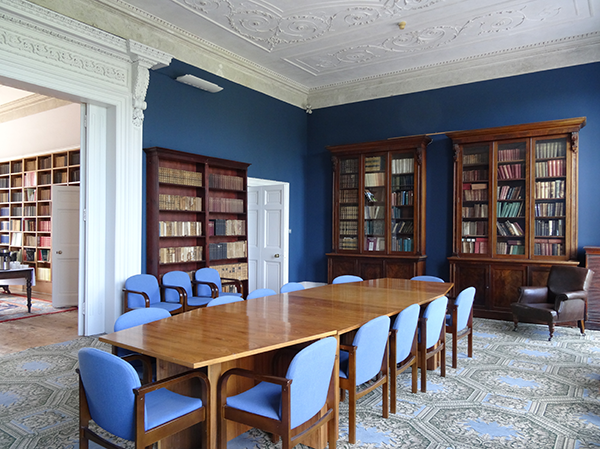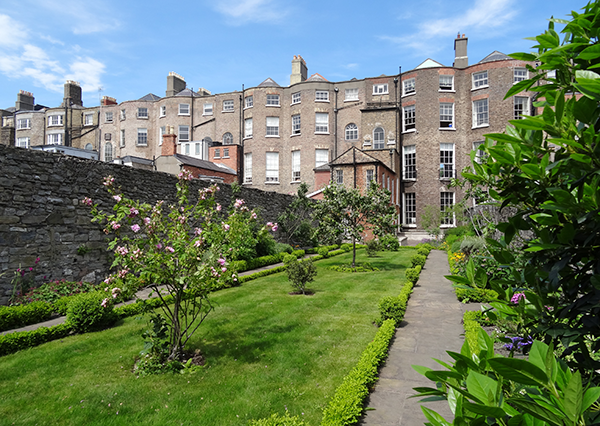Royal Society of Antiquaries of Ireland library
Published in Issue 4 (July/August 2017), Reviews, Volume 25Royal Society of Antiquaries of Ireland library
63 Merrion Square, Dublin 2
rsai@rsai.ie, +353 (0)1 6761749
Wed & Thur: 10.30am–12.30pm & 2–4.30pm
By Tony Canavan
This year the Royal Society of Antiquaries of Ireland (RSAI) is celebrating the centenary of its occupation of its premises at 63 Merrion Square. It may have been there for a century but it contains one of the lesser-known libraries in the city. Although the building has never been closed to the public (and its lectures are open to all), the RSAI has recently decided to be more proactive in encouraging access to non-members, in particular to its library on the ground floor. A tour of the entire building is possible if the other rooms are not in use, but it is advisable, especially if in a group, to phone or email ahead. Bear in mind also that the RSAI hosts a number of open days throughout the year (during Heritage Week and Open House, for example) when members give public tours of the building and its collections.

Above: The library occupies the main room on the ground floor and holds a collection of over 5,000 books.
Before considering the library, I would advise the visitor to appreciate the building itself. It is the only complete late eighteenth-century Georgian townhouse in Dublin, extending from the coal bunkers under the front pavement to the four storeys over the basement and the walled rear garden, the coach-house and stables, plus the rear wall and gate facing onto the back lane. Whichever room you are in, take a look up at the ceiling to admire the intricate design of the centuries-old stucco, the work of Andrew Callnan, influenced by Michael Stapleton, one of Ireland’s most important eighteenth-century stuccodores. Note, too, the original wrought-iron balusters and mahogany doors. On the first-floor landing is a small dome allowing light into the stairwell. Amazingly, this dome still has its original Georgian glass.

Above: One of the first-floor reception rooms—available for meetings and small ceremonies.
Besides this, the rooms and corridors are full of fixtures and fittings that would fit into any museum. For example, in the front hallway is a large oak chest, dating from 1706, which was given to the RSAI by the guild of weavers and was packed full of their records, going back beyond the eighteenth century. Above it on the wall is a magnificent pair of antlers from an Irish elk. In another room a handsome Georgian clock sits on a mantelpiece, while even the bookshelves and cupboards throughout the house are antiques. On the walls are framed maps, prints and embroidery. In the library itself is a set of wooden chairs that were used in the parliament of the Confederation of Kilkenny (these are going on loan to Rothe House, Kilkenny). Throughout the house is an eclectic array of artefacts and antiques, from wrought-iron candlesticks to medieval stone-carved gutters.
The library occupies the main room on the ground floor and holds a collection of over 5,000 books, many of which have been donated by members over the years. For example, Lord Edward Fitzgerald donated his collection of books and coins. The library contains a large selection of titles on Irish archaeology and Irish history, as well as genealogy and records relating to some of the great families of Ireland. There is an extensive local history collection organised county by county, with a particularly large number of books on Dublin. In fact, the library has the books, notes and sketches that belonged to the notable Dublin historian Francis Elrington Ball. While the library does acquire recently published books, most researchers who use it are after its old, rare books, which are unavailable elsewhere. The rarest and oldest books are kept in secured cabinets.
As well as this, the library has in excess of 5,000 journals. There is a large collection of Irish journals, most of which relate to archaeology and history, some going back to the nineteenth century. Upstairs, another room contains journals from the UK, the US and further afield. Only the RSAI holds many of these bound volumes.

Above: The RSAI’s garden, beautifully restored to reflect its original Georgian-era layout.
The RSAI is the guardian of a comprehensive collection of photographic albums and slides, primarily depicting archaeological sites in Ireland. In addition, there is a large collection of glass, or magic lantern, slides. RSAI staff and volunteers among the members are currently engaged in a project to digitally preserve the lantern slide collection and make them publicly accessible. It is estimated that there are 10,000 images in all; three years into the project, about 3,000 have been digitised and are available on-line. In addition to the photographs, the RSAI has correspondence, documents, drawings and sketches from noted antiquarians such as Miller, Robertson, Graves and Du Noyer.
It is perhaps worth mentioning that, as part of its reaching out to the public, the RSAI offers two reception rooms on the first floor, a 100-seat theatre and the walled garden for conferences, seminars, meetings, book launches, private parties, literary readings and recitals. All in all, it is well worth a visit.
Tony Canavan is editor of Books Ireland.
















